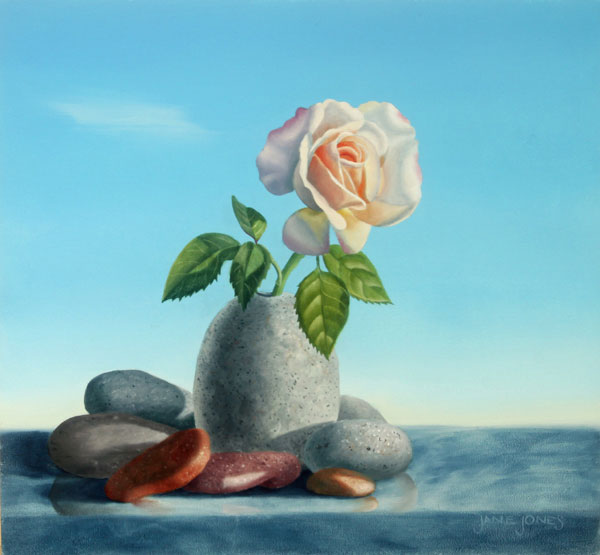Painting Illusions of Light, Part 1: Setting Up

The following is a guest blog post on still life painting and more from expert painter Jane Jones, who often contributes to The Artist’s Magazine (read her feature articles here).
Painting Illusions of Light
by Jane Jones
I think about light a lot because my paintings are about how the flowers and other objects interact with the light. Without the light, the images are totally uninteresting. So I want to talk (okay, write) about light and how to create it in a still life painting. But then I wrote it all out and it was WAY too long for one blog, so you’ll find it in three blog entries:
Part 1: Setting up to paint the illusion of light
Part 2: Considering shadows (stay tuned)
Part 3: Painting the illusion of light (stay tuned)
Part 1: Setting Up to Paint the Illusion of Light
in a Still Life Painting & More

I used to photograph at all times of the day, but for the last couple of years I’ve only been using later afternoon light. It’s more interesting and dramatic than the light at mid-day. Morning light can be really beautiful too. I look for a day that’s going to be cloudless, so the light is as bright as possible. I always prefer bright sun, nothing else. I love the drama of it, and how beautifully it illuminates flowers…it’s their “natural light.” I live in a place where we have little humidity and are at a high altitude, so the light is very bright here, and it’s familiar to me. Someone in an area with more humidity could prefer the softer light in that area, and feel that my light is too harsh. Go with what feels right for you.
If you want to create images with mystery, then using a less intense light might be exactly what you need. Or maybe you’re more familiar with rainy/overcast light, and that’s what is interesting to you. So here are my tips about how to set up your objects (still life, figurative and landscape) so that you can be successful creating light in your paintings.
1. Be sure that the objects that you want to paint are lit in an interesting way, whether you’re painting from life, or from photos.
2. Play with the orientation of the light: from the side, the top, and the other side.
3. Consider the brightness or intensity of the light. Will artificial light create the mood you want, or does your composition call for bright sunlight, or perhaps sun with overcast?
4. If you’re working from photos, be sure to take multiple exposures of your subject matter. Cameras don’t have the same sensitivity as our eyes, and if the light is bright, then you’ll need different exposures for the light areas and for the dark areas. No one photo can capture all of the information that you’ll need to work from. Learn to use your camera so that you can capture all of the information that you need. Using various exposures also allows you to choose which light you like, from over-exposed to very dark and mysterious. Sometimes I find something unexpected and wonderful in over or under-exposed images.



See how each exposure communicates differently? The top photo reference is more like bright daylight, joyful and upbeat, and shows off the glass and roses equally.
The middle one is still upbeat, but also a bit serious and intense, and the roses are somewhat more important than the glass.
And the under-exposed image has a lot of drama, and definitely is all about the roses.
They are three different expressions using the same objects. If I were to make a still life painting of this image, I would use the roses in the middle exposure image, and the glass in the middle exposure, and the drapery from the under-exposed image. They are all useful, and each exposure has some of the information that I would need to make a painting.
Click here to read Part 2: Considering Shadows in a Still Life Painting & More
Click here to read Part 3: Painting the Illusion of Light in a Still Life Painting
 Bio: Jane Jones is an award-winning artist whose paintings have been featured in many magazines, including American Art Collector and The Artist’s Magazine. She is the author of Classic Still Life Painting. Painting is her passion, as is growing the flowers that she uses in her paintings.
Bio: Jane Jones is an award-winning artist whose paintings have been featured in many magazines, including American Art Collector and The Artist’s Magazine. She is the author of Classic Still Life Painting. Painting is her passion, as is growing the flowers that she uses in her paintings.
Websites: www.janejonesartist.com and www.shopjanejonesartist.com.





Have a technical question?
Contact UsJoin the Conversation!